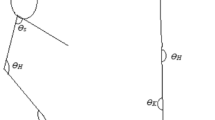Abstract
The forehand is one of the key shot in tennis. Its reparability is a very important aspect of gaining points. The first purpose of this paper is to create the algorithms for calculating the motion parameters for the preparation phase of the forehand, such as: the position of the head of the tennis racket relative to the player’s body, the elbow angle (i.e. whether the arm is bent or straight) and the placement of the player’s feet towards the front of the pelvis. The second aim of the study is to calculate the repeatability of the selected motion parameters (both for the body and the racket) of the preparation phase of the tennis forehand using coefficient of variation. The shots were performed in the motion capture laboratory using the Plug-in Gait biomechanical model. The described parameters are computed from three dimensional data, stored in C3D file.
The obtained results indicate that the placement of the head of the tennis racket towards the player’s body is repeatable only for first two defined positions (above the forehead and between it and the shoulder). The participant puts his feet repeatable, after average 46% time he puts his left leg forward. The arrangement of the arm during the preparation phase of the forehand is also repeatable.
Access this chapter
Tax calculation will be finalised at checkout
Purchases are for personal use only
Similar content being viewed by others
References
Ivančević, T., Jovanović, B., Đukić, M., Marković, S., Đukić, N.: Biomechanical analysis of shots and ball motion in tennis and the analogy with handball throws. Facta Univ. Ser. Phys. Educ. Sport 6(1), 51–66 (2008)
Skublewska-Paszkowska, M., Lukasik, E., Smolka, J.: Algorithms for tennis racket analysis based on motion data. Adv. Sci. Technol. Res. J. 10(31), 255–262 (2016)
Kato, M., Sato, T., Shimodaira, Y.: Developing of evaluation method of motion repeatability by motion capturing. In: Kommers, P., Isaías, P., Fernandez Betancort, H. (eds.) International Conferences Interfaces and Human Computer Interaction 2015, Game and Entertainment Technologies 2015 and Computer Graphics, Visualization, Computer Vision and Image Processing, CGVCVIP Proceedings, pp. 325–327, Lisbon (2015)
Ahmadi, A., Rowlands, D.D., James, D.A.: Investigating the translational and rotational motion of the swing using accelerometers for athlete skill assessment. In: IEEE sensors 2006, EXCO, Daegu, 22–25 October 2006, pp. 980–983 (2006)
de López Subijana, C., Navarro, E.: Kinetic Energy transfer during the serve. J. Hum. Sport Exerc. 4(2), 114–128 (2009). ISSN 1988-5202
Mudra, P., Psalman, V.: Evaluation of sport technique in tennis based on 3D kinematic analysis. In: Proceedings of the 10th International Conference on Kinanthropology: Sport and Quality of Life, pp. 406–414 (2016)
Elliott, N., Choppin, S., Goodwill, S.R., Allen, T.: Markerless tracking of tennis racket motion using a camera. Procedia Eng. 72, 344–349 (2014). The 2014 Conference of the International Sports Engineering Association. Elsevier
Cross, R., Bower, R.: Effects of swing-weight on swing speed and racket power. J. Sports Sci. 24(1), 23–30 (2006)
Elliott, N., Choppin, S., Goodwill, S.R., Allen, T.: Image-based visual hull of a tennis racket. Procedia Eng. 34, 877 (2012). 9th Conference of the International Sports Engineering Association (ISEA)
Washida, Y., Elliott, N., Allen, T.: Measurement of main strings movement and its effect on tennis ball spin. Procedia Eng. 72, 557–562 (2014). The 2014 Conference of the International Sports Engineering Association
Mitchell, S.R., Jones, R., King, M.: Head speed vs. racket inertia in the tennis serve. Sport Eng. 3, 99–110 (2000). doi:10.1046/j/1460-2687.2000/00051.x
Skublewska-Paszkowska, M., Lukasik, E., Smolka, J., Milosz, M., Plechawska-Wojcik, M., Borys, M., Dzienkowski, M.: Comprehensive measurements of human motion parameters in research projects. In: Candel Torres, I., Gomez Chova, L., Lopez Martinez, A. (eds.) 10th International Technology, Education and Development Conference INTED, Conference Proceedings, 6–9 March 2016, Valencia, pp. 8597–8605. IATED Academy (2016)
Plug-in Gait Model. www.irc-web.co.jp/vicon\_web/news\_bn/PIGManualver1.pdf. Accessed 15 May 2017
Reed, J.F., Lynn, F., Meade, B.D.: Use of coefficient of variation in assessing variability of quantitative assays. Clin. Diagn. Lab. Immunol. 9(6), 1235–1239 (2002). doi:10.1128/CDLI.9.6.1235-1239.2002
Acknowledgment
The research programme entitled “Biomechanical parameters of athletes in the individual exercises” based on the analysis of 3D motion data and EMG, realised in the Laboratory of Motion Analysis and Interface Ergonomics was approved by the Commission for Research Ethics, No. 2/2016 dated 8.04.2016. The authors would like to thank the Student Sports Club Tennis Academy POL-SART for their support.
Author information
Authors and Affiliations
Corresponding author
Editor information
Editors and Affiliations
Rights and permissions
Copyright information
© 2018 Springer International Publishing AG
About this paper
Cite this paper
Skublewska-Paszkowska, M. (2018). Motion Repeatability of Tennis Forehand Preparation Phase Without the Ball Using Three Dimensional Data. In: Świątek, J., Borzemski, L., Wilimowska, Z. (eds) Information Systems Architecture and Technology: Proceedings of 38th International Conference on Information Systems Architecture and Technology – ISAT 2017. ISAT 2017. Advances in Intelligent Systems and Computing, vol 656. Springer, Cham. https://doi.org/10.1007/978-3-319-67229-8_14
Download citation
DOI: https://doi.org/10.1007/978-3-319-67229-8_14
Published:
Publisher Name: Springer, Cham
Print ISBN: 978-3-319-67228-1
Online ISBN: 978-3-319-67229-8
eBook Packages: EngineeringEngineering (R0)




